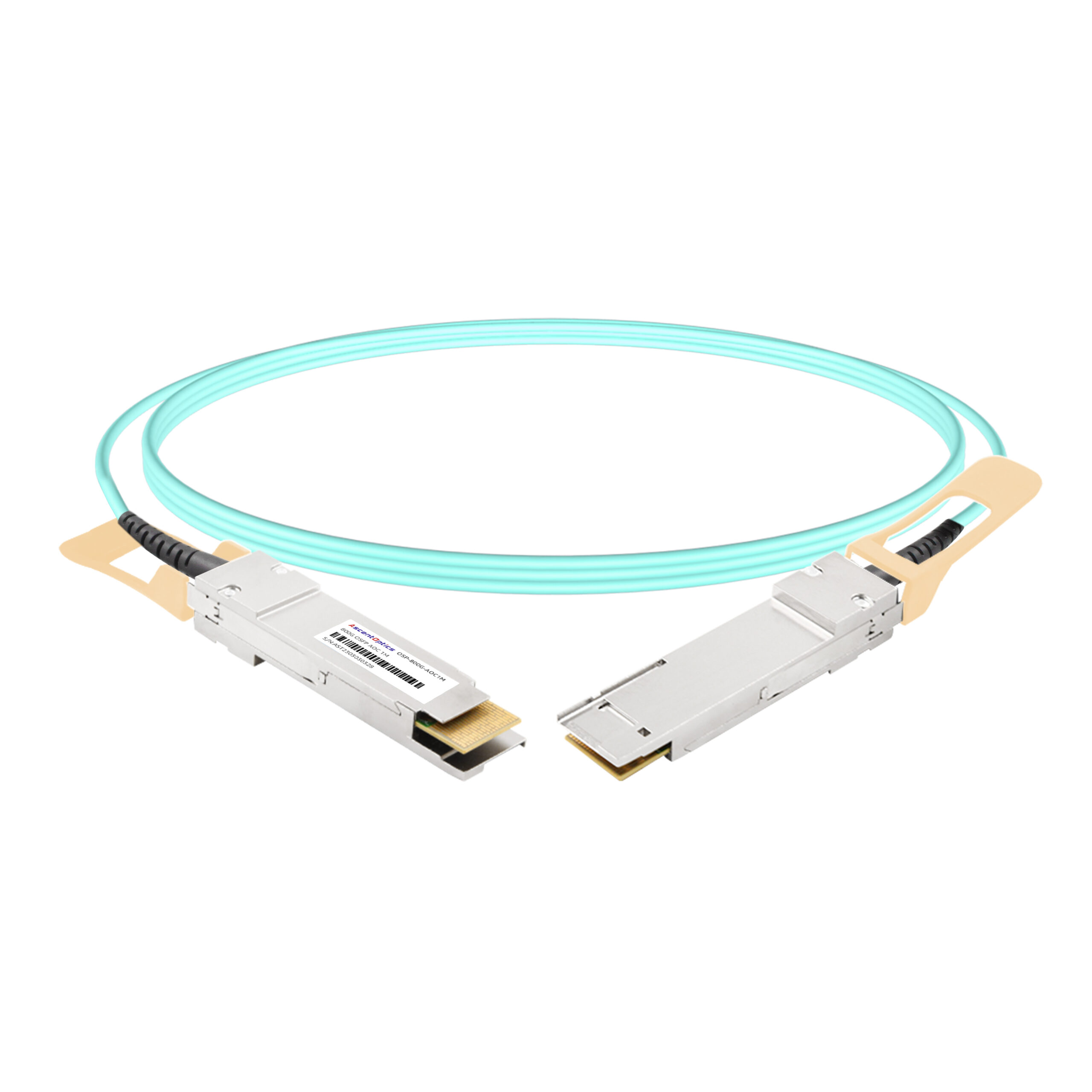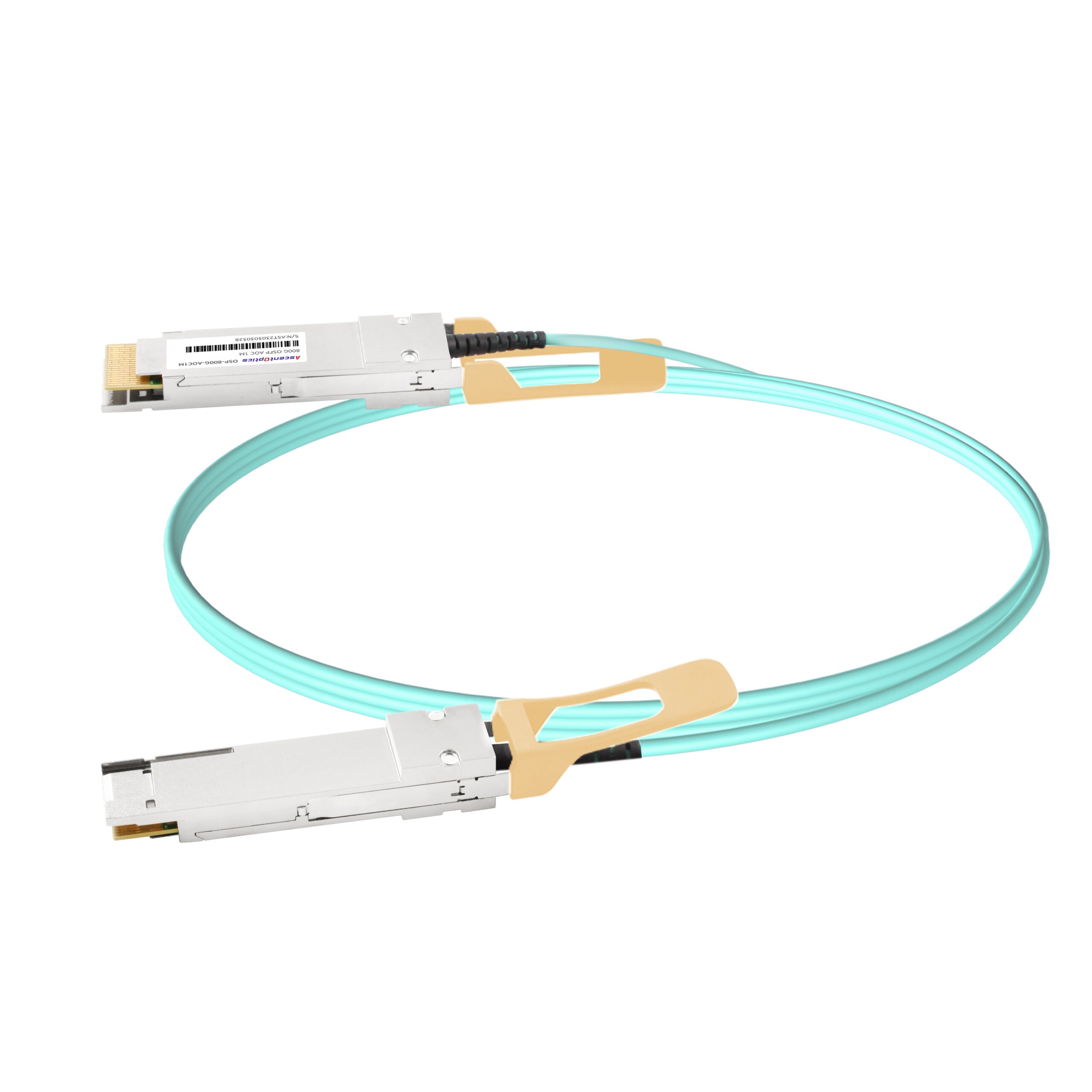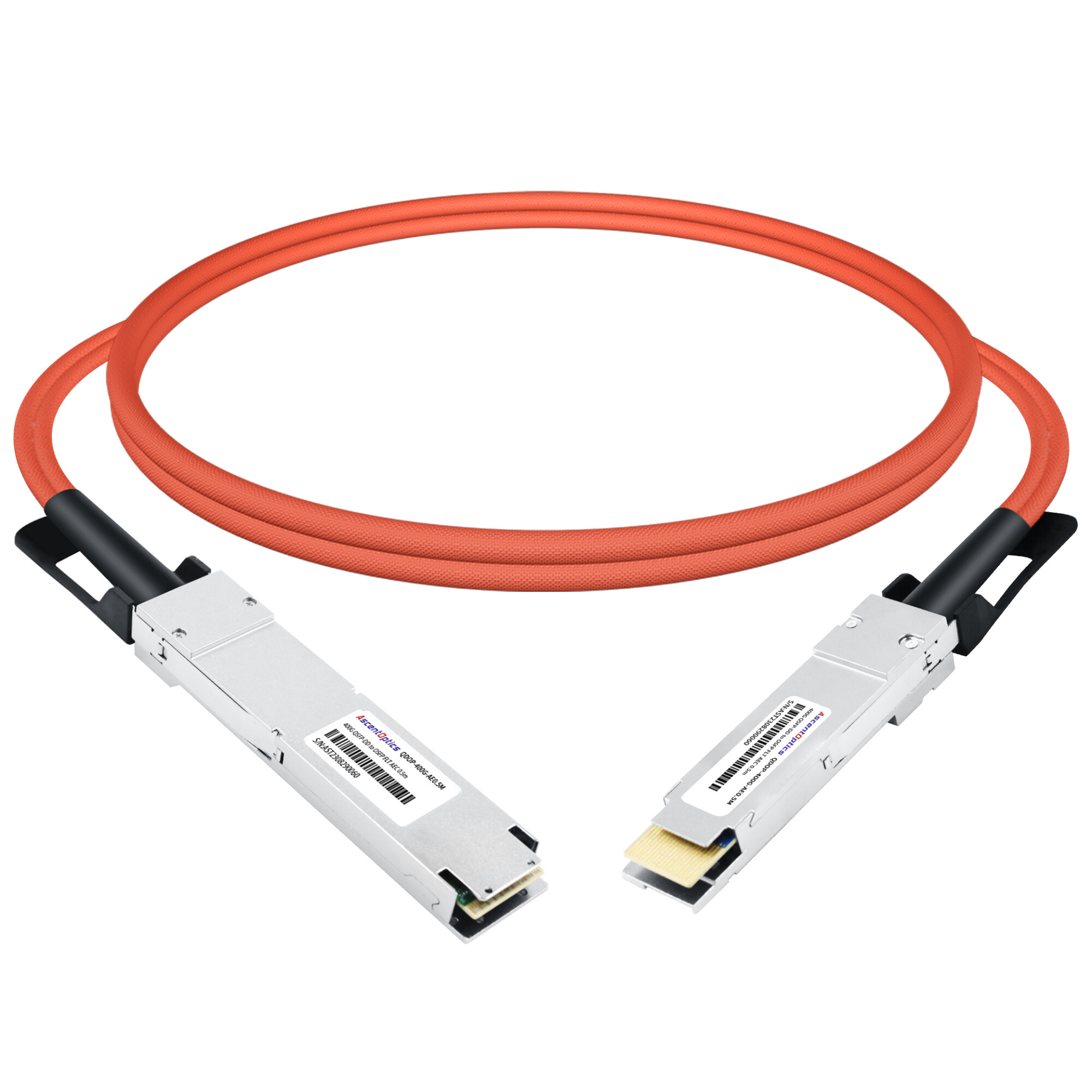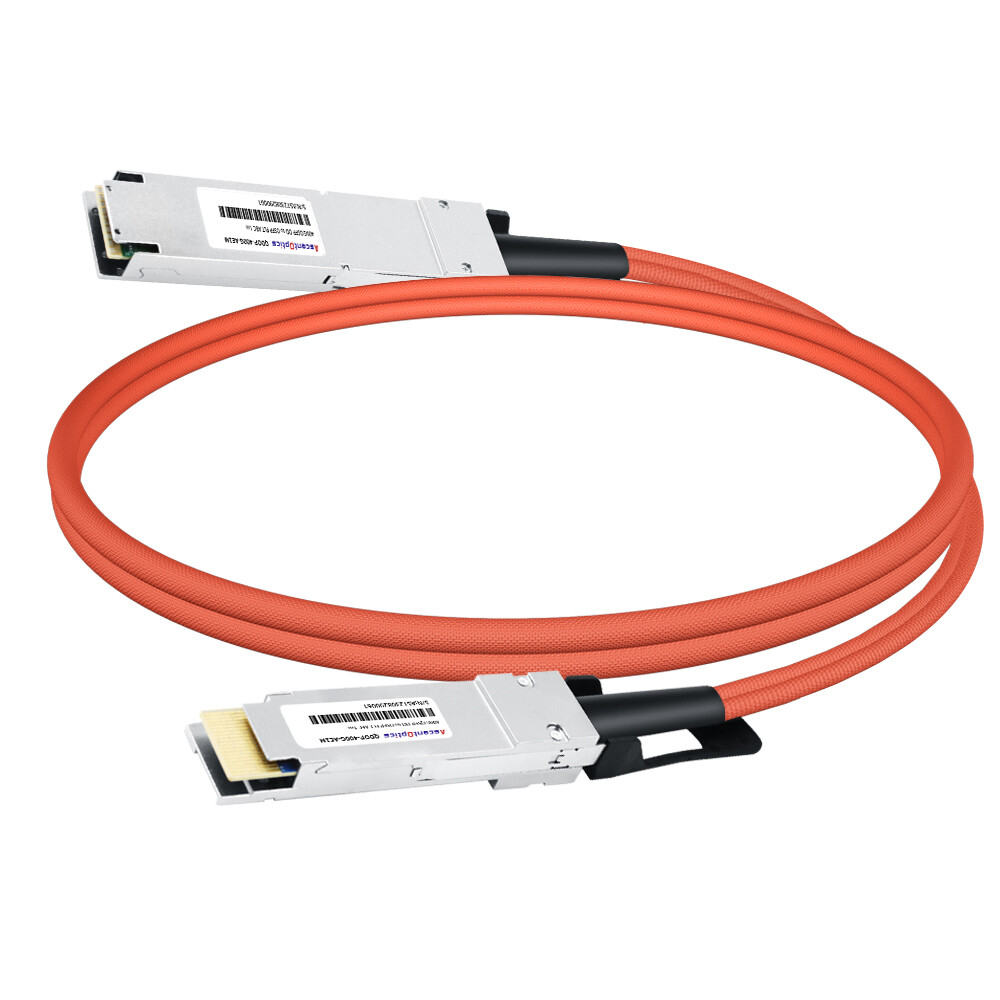According to IDC’s 2025 forecast, global data center traffic will grow to more than three times that of 2023, necessitating more efficient interconnection technologies to handle the explosive data growth. Active Optical Cable (AOC) and Active Electrical Cable (AEC), as high-speed cable solutions, are based on optical fiber and copper wire respectively, providing reliable point-to-point transmission. This article will dissect the technical differences between the two and explore practical application scenarios.
In the evolutionary journey of data centers, interconnection methods have undergone continuous iteration from traditional copper cables to optical fibers. As data rates advance from 100G and 400G toward 800G and even 1.6T, the challenges of signal integrity at the physical layer become increasingly severe. To balance performance, power consumption, and cost, AOC and AEC have emerged as two parallel development paths.
AOC utilizes optical fiber as the transmission medium, where signals are minimally affected by distance attenuation during the electro-optical-electro conversion process; whereas AEC relies on high-quality copper cables and built-in signal processing chips (such as DSP and Retimer) to achieve signal recovery and extension in pure electrical transmission. The emergence of both signifies the high-speed interconnection field’s entry into a new stage of “electro-optical collaborative optimization”—light handles long-distance, bandwidth, and anti-interference capabilities, while electricity manages short-distance, low latency, and cost control.

The 800G AOC (Active Optical Cable) is a high-speed data transmission cable that uses optical fiber as the transmission medium and integrates optoelectronic conversion modules (such as optical transceivers) at both ends of the cable. Specifically, the AOC employs a Vertical-Cavity Surface-Emitting Laser (VCSEL) at the transmitting end to convert electrical signals into optical signals, which are then transmitted through multimode optical fibers (such as OM3 or OM4). At the receiving end, a PIN photodiode (Photodiode) converts the optical signals back into electrical signals. This electro-optical-electro conversion process ensures signal integrity at high speeds, with a typical bit error rate (BER) below 10^-12.
The AOC supports various interface forms, such as OSFP or QSFP-DD, and can be configured in point-to-point or breakout structures (for example, 800G to 2x400G breakout). Its advantages lie in its lightweight design (weight approximately 25% of DAC) and resistance to electromagnetic interference (EMI), as optical fiber is non-conductive. Additionally, the AOC complies with the IEEE 802.3df standard, ensuring compatibility with existing Ethernet devices.

The 800G AEC (Active Electrical Cable) is an active cable solution based on copper wire, which integrates retimer or DSP chips inside the cable to enhance signal transmission capabilities. AEC is an enhanced version of the passive DAC (Direct Attach Cable). It incorporates active electronic components, including retimers. These components amplify signals, equalize them, and perform clock data recovery (CDR). AEC addresses common copper wire problems such as signal attenuation, crosstalk, and jitter. According to the AEC specifications from the HiWire Alliance, AEC provides standardized electrical and mechanical interfaces, supporting longer transmission distances (typically 2-9 meters, up to 5 times longer than DAC).
AEC typically adopts QSFP-DD or OSFP interfaces, supporting low-power designs (totaling approximately 10W, 25-50% lower than AOC), and improving airflow and weight management in high-density environments. Although susceptible to EMI influences, through shielding and signal compensation, AEC offers cost-effective short- to medium-distance solutions that comply with the IEEE 802.3 standard.

The differences in these principles stem from the medium: AOC leverages the low attenuation characteristics of optical fiber (attenuation coefficient α ≈ 0.2 dB/km), while AEC overcomes the resistance and capacitance effects of copper wire through electronic compensation (following Shannon’s theorem: capacity C = B log₂(1 + SNR)).
The 800G AOC and 800G AEC are two critical technologies enabling high-speed interconnects in modern data centers. Both support transmission rates of up to 800 Gbps, yet their distinct transmission media and underlying principles result in significant differences in performance, cost, and application scenarios.
These differences primarily arise from the nature of their transmission media — AOC relies on optical fiber, requiring electrical-to-optical-to-electrical (E-O-E) conversion, while AEC uses copper cable enhanced with electronic signal equalization and compensation to extend reach and maintain signal integrity.
| Aspect | 800G AOC | 800G AEC | Difference Analysis |
| Transmission Distance | 30–100 m (typical for multimode); up to 10 km for single-mode | 2–9 m (short to medium reach), up to 5× longer than passive DAC | AOC is ideal for medium to long-reach links (e.g., inter-rack), while AEC is limited to intra-rack or adjacent racks. AOC’s optical fiber provides lower loss, whereas AEC extends copper reach via DSP compensation. |
| Power Consumption | Higher (~15 W total, due to lasers and optical converters) | Lower (~10 W total or ~1.5 W per end), 25–50% less than AOC | AEC is more energy-efficient, ideal for green data centers. AOC’s E-O-E conversion increases power, though silicon photonics optimizations are reducing the gap by 2025. |
| Cost | Higher (complex optical component manufacturing; more noticeable for short links) | Lower (copper-based, better cost-performance ratio) | AEC costs about 60–80% of AOC. However, AOC becomes more cost-effective over longer distances. In 2025, AOC OSFP variants are less common due to size constraints. |
| Weight & Form Factor | Lighter (about 25% of DAC weight); flexible fiber for easier routing | Slightly heavier (copper core), still suitable for high-density environments | Both outperform DAC in flexibility and density. However, at higher bandwidths, AEC cable diameter increases slightly, while AOC enhances airflow and space utilization. |
| EMI Resistance | Excellent (optical fiber immune to electromagnetic interference) | Moderate (copper more prone to EMI despite shielding and equalization) | AOC offers superior reliability in EMI-intensive environments such as AI clusters. AEC may require additional shielding, potentially increasing latency. |
| Signal Integrity | High (low BER <10^-12, minimal dispersion) | High (DSP compensates jitter and crosstalk, but may close eye diagrams) | AOC maintains better signal stability at higher frequencies, while AEC’s retimer improves SNR but adds microsecond-level latency. |
| Maintenance & Reliability | More complex (failures require full replacement; fiber sensitive to bending) | Easier (electrical components repairable; copper more durable) | AEC is simpler to deploy and maintain, while AOC offers longer lifespan (MTBF >10^6 hours). However, 2025 supply chain constraints may affect AOC availability. |
In short, AOC excels in bandwidth and signal quality, while AEC stands out for efficiency and flexibility — together enabling the future of high-speed data center interconnects.
As data centers advance toward 800Gbps connectivity, selecting the right interconnect solution has become critical. AOC (Active Optical Cable) and AEC (Active Electrical Cable) have emerged as two mainstream 800G options. Both deliver ultra-high-speed transmission, yet they differ significantly in transmission medium, power consumption, distance, and cost. Choosing between them ultimately depends on the network architecture and operational requirements.

AOC: Typically supports 30–100 meters over multimode fiber, and up to 10 km or more with single-mode variants. Ideal for inter-row or inter-rack connections.
AEC: Typically 2–9 meters, longer than passive DAC but limited by copper signal loss. Best for intra-rack or adjacent-rack connections.
Recommendation: For connections beyond 10 meters, choose AOC to ensure signal integrity. For short, low-latency links (e.g., within AI clusters), AEC is more efficient.
AOC: Higher, due to the complexity of optical components — particularly noticeable in shorter-reach deployments.
AEC: Lower, copper-based, costing about 60–80% of AOC, positioned between DAC and AOC.
Recommendation: For budget-conscious deployments, AEC offers excellent cost efficiency. For scalable and future-proof infrastructures, AOC remains the better long-term investment.
AOC: Lighter (about 25% the weight of a DAC), highly flexible, and ideal for high-density cabling and airflow management.
AEC: Slightly heavier due to copper conductors but durable and easy to install, supporting frequent plug-and-play use.
Recommendation: In space-constrained or frequently maintained environments, choose AOC for easier deployment. AEC is better suited for short-reach applications where durability is a priority.
AOC: Excellent immunity — optical fiber is electrically insulated and unaffected by EMI, offering BER <10^-12, ideal for noise-prone environments.
AEC: Moderate — copper is more susceptible to EMI, though retimers enhance signal quality. Reliability remains high, with MTBF >10^6 hours.
Recommendation: In EMI-intensive zones (e.g., AI server clusters), AOC ensures stable performance. In controlled environments, AEC provides sufficient reliability.
AOC: 800G AOC is primarily used for medium- to long-distance interconnects in data centers, such as inter-row or inter-rack connections, distributed cloud environments, and high-performance computing (HPC) clusters. It is especially popular in AI-driven networks, where it connects 800G switches to 400G endpoints, supporting low-latency backbone links. For example, in hyperscale data centers such as AWS or Google, AOC is often deployed for server-to-TOR (Top of Rack) connections, optimizing bandwidth utilization while minimizing EMI interference.
AEC: 800G AEC is designed for short- to medium-reach internal connections, including intra-rack interconnects, adjacent-rack links, and connections between storage subsystems and compute nodes. In AI supercomputing environments, AEC offers a cost-effective solution that simplifies cabling and enhances thermal management. It is particularly suitable for high-density deployments, such as edge data centers or HPC nodes, where space, power, and cost efficiency are critical factors.
Recommendation: In AI/HPC environments, choose AEC for short, high-density links, and AOC for scalable, longer-distance connections. Both support OSFP and QSFP-DD interfaces and can be deployed in breakout configurations.
These differences define their role positioning: AEC is efficient and economical in short-distance dense interconnections, while AOC is indispensable in high-performance, long-distance interconnections.
AOC and AEC each have their strengths in the 800G era; the former dominates long-distance transmission, while the latter optimizes short-link costs. In the future, with technological integration, the two will jointly drive data center innovation.